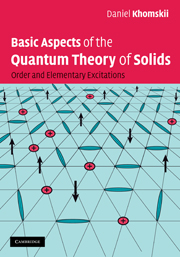Book contents
- Frontmatter
- Contents
- Foreword and general introduction
- 1 Some basic notions of classical and quantum statistical physics
- 2 General theory of phase transitions
- 3 Bose and Fermi statistics
- 4 Phonons in crystals
- 5 General Bose systems; Bose condensation
- 6 Magnetism
- 7 Electrons in metals
- 8 Interacting electrons. Green functions and Feynman diagrams (methods of field theory in many-particle physics)
- 9 Electrons with Coulomb interaction
- 10 Fermi-liquid theory and its possible generalizations
- 11 Instabilities and phase transitions in electronic systems
- 12 Strongly correlated electrons
- 13 Magnetic impurities in metals, Kondo effect, heavy fermions and mixed valence
- Bibliography
- Index
10 - Fermi-liquid theory and its possible generalizations
Published online by Cambridge University Press: 05 June 2012
- Frontmatter
- Contents
- Foreword and general introduction
- 1 Some basic notions of classical and quantum statistical physics
- 2 General theory of phase transitions
- 3 Bose and Fermi statistics
- 4 Phonons in crystals
- 5 General Bose systems; Bose condensation
- 6 Magnetism
- 7 Electrons in metals
- 8 Interacting electrons. Green functions and Feynman diagrams (methods of field theory in many-particle physics)
- 9 Electrons with Coulomb interaction
- 10 Fermi-liquid theory and its possible generalizations
- 11 Instabilities and phase transitions in electronic systems
- 12 Strongly correlated electrons
- 13 Magnetic impurities in metals, Kondo effect, heavy fermions and mixed valence
- Bibliography
- Index
Summary
As we have seen in the previous chapters, interactions, if they are not too strong, preserve many features of the electronic system which are present in the noninteracting case (Fermi gas, Chapter 7). In general, however, the interactions are not at all small: for instance in typical metals, rs ∼ 2–3, and not rs « 1 as was implicitly assumed in Chapter 9 and which was actually the condition for the applicability of perturbation theory used there. Nevertheless we know that the description of normal metals using the concepts developed for the free Fermi gas or Fermi systems with weak interactions (such asDrude theory, for example) is very successful.
An explanation of the success of the conventional theory of metals, and the generalization of the corresponding description to a more general situation, was given by Landau in his theory of Fermi liquids. This theory is very important conceptually, although in the usual metals there are only few special effects which indeed require this treatment. However, there exist also systems (3He, or rare earth systems with mixed valence and heavy fermions) for which this approach is really vital. Also the emerging new field of non-Fermi-liquid metallic systems requires first an understanding of what is the normal Fermi liquid.
The foundations of the Fermi-liquid theory
Themain assumptions of the Landau Fermi liquid theory are completely in linewith our general approach.
- Type
- Chapter
- Information
- Basic Aspects of the Quantum Theory of SolidsOrder and Elementary Excitations, pp. 175 - 187Publisher: Cambridge University PressPrint publication year: 2010



